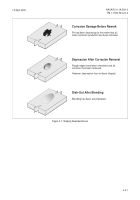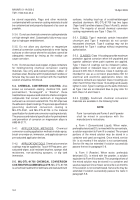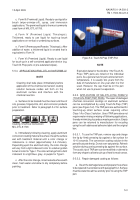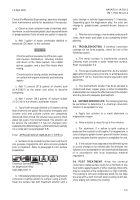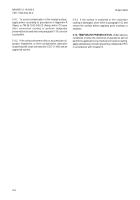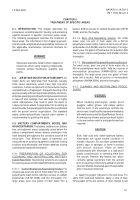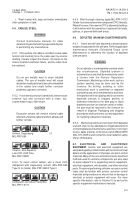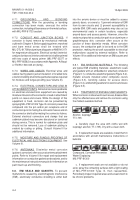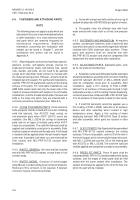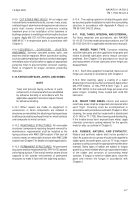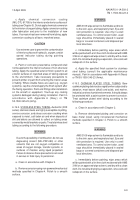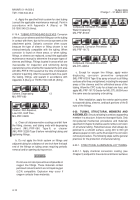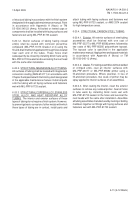TM-1-1500-344-23-2 - Page 106 of 240
6-2
NAVAIR 01-1A-509-2
TM 1-1500-344-23-2
15 April 2009
indicates an acid contaminated area. For spills from
nickel-cadmium batteries, apply a strip of red litmus
paper to the wet surface. A color change to blue indicates
an alkaline contaminated area.
b. Apply the correct neutralizing solution to the areas
where the litmus paper has been applied. Use a 10
percent sodium bicarbonate solution (see paragraph
6-3.1.1) to neutralize sulfuric acid from lead acid
batteries. Use a boric acid solution (see paragraph
6-3.1.2) or a monosodium phosphate solution (see
paragraph 6-3.1.3) to neutralize potassium hydroxide
from nickel-cadmium batteries. Ensure that the area is
well-saturated including all seams and crevices where
electrolyte could collect. Use care to prevent neutralizing
solutions from spreading to adjacent areas, and ensure
that bilge area drains are open to allow fluids to flow
overboard. Allow the neutralizing solution to remain on
the surface for at least five minutes or until all bubbling
action ceases, whichever is longer.
c. Rinse the area thoroughly with a liberal amount of
clean water.
d. Remove any standing liquid or puddles with a
squeeze bulb type syringe, absorbent cloth, or sponge.
Place the used items in a leak-proof container for
disposal to prevent the contamination of other areas.
e. Reapply the litmus paper, as in paragraph a. If
the litmus paper does not change color, rinse the area,
as in paragraph c, and dry the areas with clean cloths or
rags. If the litmus paper changes color, repeat
paragraphs b and c.
f. Apply chemical conversion coating treatment
(Chapter 5), sealant (Chapter 7), or paint coatings
(Appendix A), as required.
6-3.3. PAINT SYSTEMS. Special acid and/or alkali
resistant coatings are usually required for battery
compartments, boxes, and areas. Refer to the applicable
aircraft manuals.
6-4.
BERYLLIUM-COPPER ALLOYS.
Surface
discoloration of beryllium copper alloys is normal and
removal is not advised. If removal is required, minimize
the generation of fine beryllium dust particles as much
as possible.
a. Wear disposable coveralls, gloves, hood, and
cartridge respirator. Consult local safety office for
requirements.
Solvent, Degreasing
13
MIL-PRF-680
b. Dampen abrasive mat (A-A-58054) with
degreasing solvent (MIL-PRF-680).
WARNING
Dust, corrosion products, and other fine particles
generated by beryllium and beryllium-copper
alloys are toxic when inhaled or allowed to
contact the skin. Severe poisoning can result if
beryllium dust is inhaled. Beryllium-copper
alloys shall be cleaned only in strict accordance
with the following procedure or the procedure of
the applicable maintenance manual.
c. To prevent the spread of toxic dust, keep mat wet
throughout the corrosion removal process.
d. Clean fitting with disposable towels dampened
with MIL-PRF-680 after the completion of corrosion
removal.
Compound, Corrosion Preventive
4
Water Displacing
MIL-PRF-81309
e. Apply corrosion preventive compound,
MIL-PRF-81309 Type II, on bushings, or MIL-PRF-81309
Type III, on contacts.
Solvent, Degreasing
13
MIL-PRF-680
f. Wipe work area clean with disposable towels
dampened with degreasing solvent (MIL-PRF-680).
g. Place disposable towels, abrasive mats, and
coveralls in a plastic bag marked "Beryllium
contaminated waste".
h. Seal plastic bag with tape (AMS D6123 Type II).
i. Discard plastic bag in accordance with local
environmental protection directives.
Back to Top


